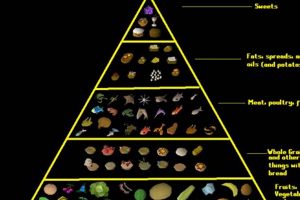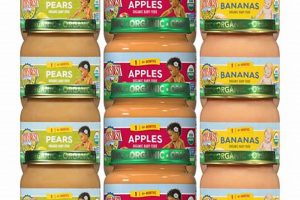Shelf-stable sustenance options suitable for outdoor excursions where refrigeration is unavailable or impractical constitute a critical element of trip planning. These provisions are characterized by their extended usability without spoilage, even under varying environmental conditions. Examples include dehydrated meals, canned goods, freeze-dried fruits, and certain types of processed meats.
The selection of such foodstuffs is paramount for ensuring adequate nutritional intake and preventing foodborne illnesses during activities like wilderness trekking and remote site lodging. Historically, reliance on preserved commodities has been essential for exploration, military campaigns, and disaster relief efforts, highlighting the enduring value of shelf-stable food solutions.
This analysis explores the key categories of provisioning in this manner, examining factors such as nutritional content, portability, ease of preparation, and longevity. These aspects will inform a discussion of specific items and strategies for optimizing meal planning in environments where freshness is not an option.
Optimizing Shelf-Stable Food Choices for Outdoor Expeditions
Careful consideration when selecting preserved commodities for camping enhances safety, enjoyment, and nutritional intake during outdoor activities.
Tip 1: Prioritize Caloric Density: Opt for options offering a high calorie-to-weight ratio. Items such as nuts, seeds, and dried fruits provide substantial energy in a compact form, reducing pack weight and maximizing sustenance.
Tip 2: Emphasize Nutritional Completeness: Beyond mere caloric intake, ensure provisions include essential vitamins, minerals, and protein. Dehydrated meals often incorporate these elements, but supplementation with items like protein bars or fortified snacks can further enhance dietary balance.
Tip 3: Consider Preparation Requirements: Evaluate the complexity of food preparation in the field. Meals requiring extensive cooking or hydration may be less practical than those requiring minimal intervention. Instant oatmeal, for example, is easily prepared with boiled water.
Tip 4: Manage Packaging Waste: Choose items with minimal packaging or packaging that can be easily compacted. Excess waste increases pack volume and environmental impact. Resealable bags and reusable containers are useful for managing leftovers and waste.
Tip 5: Protect from Environmental Factors: Store provisions in waterproof and airtight containers to prevent spoilage due to moisture or pest intrusion. Properly sealed containers extend shelf life and maintain food quality.
Tip 6: Diversify the Food Supply: Avoid monotony by including a variety of flavors and textures. A diverse menu can improve morale and encourage adequate food consumption throughout the trip. Consider items like jerky, dried vegetables, and shelf-stable cheeses.
Effective planning and informed selection of supplies are integral to safe and enjoyable outdoor pursuits. The above considerations enhance comfort and reduce potential risks associated with inadequate or inappropriate provisioning.
The subsequent section explores specific commodity categories that exemplify the above principles.
1. Caloric Density
Caloric density, defined as the number of calories per unit of weight or volume, is a critical factor in selecting optimal sustenance for outdoor activities. The primary goal is to minimize the weight and bulk of provisions while maximizing energy availability. This consideration is especially important in situations where physical exertion is high and resupply is infrequent or impossible. The inherent relationship is causal; a higher caloric density directly contributes to reduced pack weight and increased energy reserves.
The importance of caloric density within the context of shelf-stable food options lies in its direct influence on logistical feasibility and individual performance. For instance, 100 grams of uncooked rice provides approximately 360 calories, while 100 grams of dehydrated trail mix, rich in nuts and seeds, can yield upwards of 500 calories. This disparity underscores the efficiency gains achieved through prioritizing energy-dense provisions. Practical significance is demonstrated in multi-day backpacking trips where every gram counts; choosing items like nut butters, dried fruits, and energy bars becomes strategically advantageous.
In summary, caloric density serves as a key metric for evaluating the suitability of long-lasting sustenance options for camping and similar activities. The ability to efficiently pack and transport sufficient energy reserves is directly linked to the success and safety of such endeavors. By prioritizing food items with high caloric density, individuals can optimize their load and maximize their performance, addressing the fundamental challenge of resource management in remote environments.
2. Nutrient profile
The nutrient profile of shelf-stable provisions is a critical determinant of their suitability for extended outdoor excursions. Ensuring adequate intake of essential macronutrients and micronutrients is paramount for maintaining health, energy levels, and cognitive function in demanding environments.
- Macronutrient Composition
Macronutrientsprotein, carbohydrates, and fatsprovide energy and building blocks for bodily functions. Adequate protein intake is essential for muscle repair and maintenance, especially during strenuous activity. Carbohydrates fuel physical exertion, while fats support hormone production and nutrient absorption. Dehydrated beans offer a significant source of protein and complex carbohydrates, while nuts and seeds provide healthy fats and additional protein. Imbalances in macronutrient ratios can lead to fatigue, impaired recovery, and health complications.
- Micronutrient Adequacy
Micronutrients, including vitamins and minerals, are crucial for various physiological processes. Vitamin deficiencies can impair immune function, energy metabolism, and cognitive performance. Electrolyte imbalances, particularly sodium and potassium, can result from excessive sweating during physical activity. Dried fruits, such as apricots and raisins, provide potassium, while fortified cereals can supply essential vitamins and minerals. A diverse selection of shelf-stable items is recommended to address micronutrient needs.
- Fiber Content
Dietary fiber promotes digestive health and regularity, which can be challenged by changes in diet and activity levels during outdoor expeditions. Insoluble fiber adds bulk to the stool, preventing constipation, while soluble fiber helps regulate blood sugar levels. Whole grain crackers and dried vegetables offer a source of dietary fiber. Insufficient fiber intake can lead to digestive discomfort and reduced nutrient absorption.
- Sodium Levels
Sodium is an essential electrolyte, but excessive intake can contribute to hypertension and fluid retention. Processed and preserved rations often contain high sodium levels to enhance palatability and extend shelf life. Monitoring sodium intake and balancing it with potassium-rich foods is important for maintaining fluid balance and cardiovascular health. Opting for low-sodium options or supplementing with fresh produce when available is recommended.
The selection of long-lasting sustenance options must account for the totality of their nutrient profile, ensuring that they meet the nutritional demands of the planned activity. A well-balanced dietary approach, incorporating diverse commodity categories, is crucial for sustaining physical and cognitive well-being during extended trips. Understanding the nuances of macronutrient ratios, micronutrient availability, fiber content, and sodium levels allows for informed decision-making and optimizes the effectiveness of provisioning.
3. Shelf Stability
Shelf stability constitutes a foundational attribute of provisioning intended for outdoor activities. Without adequate resistance to degradation, sustenance becomes unusable, creating logistical and health risks. The duration a product retains acceptable quality under specified storage conditions directly correlates with its suitability for remote expeditions. Best non perishable food for camping is, by definition, characterized by this inherent ability to withstand deterioration.
The relationship between shelf stability and provisioning choices is causal. Products processed through canning, dehydration, or freeze-drying exhibit prolonged usability compared to fresh alternatives. Canned meats, for example, provide a source of protein that can last for years without refrigeration. Dehydrated fruits and vegetables retain nutritional value and palatability for extended periods. The reliance on these methods is not arbitrary; they mitigate spoilage mechanisms, such as microbial growth and enzymatic activity. In contrast, fresh produce, while nutritionally desirable, is impractical due to rapid degradation, requiring immediate consumption or specialized preservation techniques beyond the scope of typical camping scenarios.
The practical significance of understanding shelf stability lies in informed decision-making regarding provisioning strategies. When evaluating options, assessment of the expected environmental conditions, storage constraints, and trip duration is essential. Products must withstand temperature fluctuations, humidity, and potential physical damage during transportation. An understanding of product expiration dates and proper storage protocols is crucial for minimizing waste and ensuring the availability of usable resources. Ignoring these factors increases the risk of food spoilage and compromises the safety and effectiveness of the expedition. Consequently, shelf stability serves as a primary determinant of suitability within the broader context of commodity selection for outdoor pursuits.
4. Portability
Portability is a critical consideration in the selection of provisions for outdoor activities, directly impacting logistical efficiency and comfort. The ability to easily transport and manage sustenance is paramount, particularly in scenarios involving backpacking or extended distances from supply points. The selection of shelf-stable commodities often hinges on their capacity to minimize weight and volume without compromising nutritional value.
- Weight Optimization
Minimizing the weight of provisions is crucial for reducing physical strain and improving mobility. Lightweight options, such as freeze-dried meals and dehydrated snacks, are preferred over heavier alternatives like canned goods. For example, a single serving of freeze-dried chili weighs significantly less than its canned counterpart, offering comparable nutritional benefits with a fraction of the weight. This weight reduction translates directly into increased endurance and reduced fatigue during treks.
- Volume Efficiency
Reducing the volume of provisions is equally important for optimizing pack space. Compact and compressible items, such as vacuum-sealed packets and energy bars, allow for efficient storage within backpacks. Bulky or awkwardly shaped commodities can consume valuable space, limiting the capacity for other essential gear. The use of compression sacks and packing strategies can further enhance volume efficiency, maximizing the available storage within a given container. Proper management of volume contributes to balanced load distribution and improved comfort during transport.
- Packaging Durability
The integrity of food packaging is essential for preventing damage and contamination during transit. Durable, waterproof packaging protects provisions from moisture, physical impact, and puncture. Resealable bags and containers are advantageous for preserving freshness and preventing spills. Damaged packaging can compromise shelf life and render commodities unusable. Choosing products with robust and reliable packaging minimizes the risk of spoilage and maintains the quality of sustenance throughout the expedition.
- Ease of Access
Convenient access to provisions is crucial for efficient meal preparation and consumption. Organizing sustenance within a backpack or storage container should prioritize accessibility. Commonly used items should be readily available, while less frequently consumed provisions can be stored in more remote compartments. Clear labeling and strategic placement of commodity categories streamlines the meal preparation process and minimizes the time spent searching for specific items. Ease of access enhances convenience and reduces frustration during outdoor activities.
The facets of weight optimization, volume efficiency, packaging durability, and ease of access collectively define the portability of long-lasting sustenance options. Prioritizing these factors ensures that provisions can be transported and managed effectively, contributing to a more comfortable and efficient outdoor experience. The integration of portability considerations into commodity selection is essential for optimizing logistical performance and maximizing the enjoyment of wilderness pursuits.
5. Preparation ease
The degree of effort required to render preserved food suitable for consumption directly affects its practicality for outdoor activities. Factors such as time, resources, and environmental constraints dictate the permissible complexity of preparation procedures. A primary determinant of selecting the best long-lasting provisions for camping involves evaluating the ease with which they can be transformed into consumable meals.
- Minimal Resource Dependency
Foodstuffs requiring minimal external resources, such as fuel or specialized equipment, are advantageous. Items that can be consumed directly from their packaging or require only the addition of water reduce logistical burdens. For instance, ready-to-eat pouches of tuna or single-serving packets of instant oatmeal offer sustenance without necessitating elaborate cooking setups. This reduces reliance on scarce resources and streamlines meal preparation processes.
- Simplified Cooking Procedures
Provisions demanding simple cooking techniques enhance efficiency in outdoor environments. Dehydrated meals requiring only boiling water for reconstitution minimize time spent on food preparation. Conversely, items needing extensive simmering or baking are less practical due to the time and fuel required. Selecting provisions that align with available cooking capabilities optimizes resource utilization and ensures timely meal provision.
- Reduced Cleanup Requirements
Foodstuffs generating minimal waste and requiring straightforward cleanup procedures are highly desirable. Meals that can be consumed directly from their packaging or leave minimal residue reduce the need for extensive washing and waste disposal. Examples include energy bars and dried fruits, which produce little to no waste. This minimizes environmental impact and reduces the time and effort dedicated to post-meal cleanup activities.
- Environmental Adaptability
Commodities that remain amenable to preparation under varying environmental conditions exhibit enhanced practicality. Provisions that can be effectively reconstituted or heated even in cold or windy conditions offer greater reliability. Freeze-dried meals, for instance, typically reconstitute efficiently with cold or lukewarm water, mitigating the need for intense heat. Adaptability to environmental factors ensures consistent and dependable sustenance regardless of external circumstances.
These considerations underscore the integral role of preparation ease in the selection of shelf-stable food options. Prioritizing minimal resource dependency, simplified cooking procedures, reduced cleanup requirements, and environmental adaptability ensures that provisions can be efficiently and effectively transformed into consumable meals, optimizing the overall outdoor experience and mitigating logistical challenges.
6. Waste management
The effective handling of refuse generated by provisions is an inextricable component of responsible outdoor activity. The selection of items for remote expeditions directly influences the volume, composition, and environmental impact of waste streams. Best non perishable food for camping choices must, therefore, consider waste reduction strategies as a primary criterion. Improper waste disposal practices can contaminate water sources, attract wildlife, and degrade the aesthetic value of natural environments. The connection is causal; the inherent properties of chosen food influence subsequent waste management challenges.
Strategies for mitigating waste associated with shelf-stable commodities include selecting items with minimal packaging, employing reusable containers, and implementing thorough waste segregation protocols. The use of dehydrated meals with concentrated nutritional content reduces the quantity of packaging relative to fresh alternatives. Carrying out all refuse, including biodegradable materials, prevents habitat disturbance and minimizes the potential for wildlife encounters. Complete combustion of paper products, conducted within designated fire pits and in accordance with local regulations, can further reduce waste volume. These actions exemplify practical applications of integrating waste management considerations into commodity planning.
In summary, waste management represents a crucial element of responsible outdoor sustenance. While the selection of provisions is often driven by factors such as caloric density and shelf life, the imperative to minimize environmental impact necessitates a comprehensive approach to waste mitigation. Choosing foods that inherently generate less waste, coupled with conscientious disposal practices, is paramount. Challenges remain in promoting widespread adherence to Leave No Trace principles, but the practical significance of responsible waste management cannot be overstated in preserving the integrity of natural ecosystems for future generations.
7. Palatability
The subjective acceptability of provisions is a significant determinant of consumption rates and nutritional intake, especially during prolonged outdoor activities. While shelf life and caloric density are critical factors in selecting long-lasting commodities, the willingness to consume those commodities consistently is equally crucial. The concept of palatability addresses this aspect of food selection, influencing adherence to nutritional plans and overall well-being.
- Sensory Appeal and Flavor Variety
The sensory properties of provisions, including taste, texture, aroma, and visual presentation, directly influence palatability. Repetitive consumption of monotonous flavors or textures can lead to sensory-specific satiety, reducing overall intake. Incorporating a variety of flavor profiles and textures enhances palatability, encouraging consistent consumption. Examples include diversifying meal options with sweet, savory, and spicy components. The availability of freeze-dried fruits, seasoned jerky, and flavored nut butters can contribute to a more appealing and nutritionally balanced diet. The practical significance lies in mitigating dietary fatigue and maintaining adequate nutrient consumption during extended camping trips.
- Cultural and Individual Preferences
Cultural and individual preferences play a substantive role in food acceptability. Provisions that align with familiar flavors and textures are more likely to be consumed readily. Understanding the dietary backgrounds and preferences of individuals participating in outdoor activities is important for selecting appropriate commodities. Providing options that accommodate dietary restrictions, allergies, and cultural norms enhances palatability and promotes inclusivity. The consideration of individual preferences ensures that provisions are not only shelf-stable and nutritious but also acceptable and enjoyable to consume.
- Psychological Factors and Comfort Foods
Psychological factors, such as associations with positive memories or emotional comfort, can influence food acceptability. Provisions that evoke feelings of familiarity or nostalgia can provide psychological comfort in challenging environments. Incorporating “comfort foods” into the commodity selection can enhance morale and improve overall well-being. Examples include familiar snack items, such as cookies or crackers, or traditional dishes adapted for shelf stability. The psychological benefits of palatable provisions can contribute to increased adherence to meal plans and improved mood during outdoor expeditions.
- Texture and Hydration Considerations
The texture of shelf-stable provisions can significantly impact palatability, particularly in dehydrated or freeze-dried commodities. Rehydrating these items properly is essential for achieving optimal texture and palatability. Insufficiently hydrated meals can be unappetizing, leading to reduced consumption. Providing adequate water and allowing sufficient time for reconstitution improves the texture and overall acceptability of these items. The selection of provisions with desirable textures, such as chewy dried fruits or crunchy granola, can enhance palatability and encourage consistent consumption.
These elements directly influence overall sustenance compliance and psychological well-being when exploring options for provisions designed to endure prolonged storage periods. While primary considerations involve durability and nutritional content, the element of taste acceptance proves crucial in maintaining overall efficacy when integrating a viable collection of provisioning options.
Frequently Asked Questions
The following addresses common inquiries regarding the selection and utilization of non-perishable commodities for camping and related activities.
Question 1: How can the shelf life of long-lasting provisions be maximized?
Proper storage is paramount. Commodities should be stored in cool, dark, and dry environments. Airtight and waterproof containers are essential to prevent moisture absorption and pest intrusion. Adherence to manufacturer-specified expiration dates is also crucial.
Question 2: What are the primary criteria for selecting provisions for a multi-day backpacking trip?
Caloric density, nutrient profile, weight, volume, and preparation ease are key considerations. Commodities should provide sufficient energy and essential nutrients while minimizing pack weight and preparation time.
Question 3: How can variety be incorporated into a diet consisting primarily of long-lasting commodities?
A diverse selection of provisions, encompassing different flavor profiles and textures, is recommended. Incorporating dried fruits, nuts, seeds, jerky, and fortified meal replacements can enhance palatability and nutritional completeness.
Question 4: What measures should be taken to prevent foodborne illnesses when consuming non-perishable items?
Adherence to proper hygiene practices is essential. Hands should be washed thoroughly before handling food. Cooking surfaces and utensils should be clean. Damaged or expired commodities should be discarded.
Question 5: How does altitude affect cooking times for dehydrated meals?
At higher altitudes, water boils at lower temperatures, potentially increasing cooking times. Allow additional time for rehydration and consider using a pressure cooker to reduce cooking times.
Question 6: What are the best practices for disposing of food waste in wilderness areas?
Adherence to Leave No Trace principles is paramount. All food waste, including biodegradable materials, should be packed out. Burying food waste is discouraged, as it can attract wildlife and contaminate water sources.
Effective planning and adherence to best practices are essential for ensuring safe and enjoyable experiences utilizing long-lasting sustenance for your camping trip.
The succeeding section explores considerations for specific dietary needs within the context of planning your wilderness journey.
Conclusion
This analysis has explored fundamental considerations for “best non perishable food for camping,” encompassing caloric density, nutritional profiles, shelf stability, portability, preparation ease, waste management, and palatability. These elements interact to determine the suitability of a given provision for extended outdoor activities where refrigeration and resupply are limited. Effective integration of these criteria ensures both sustenance and minimizes environmental impact.
The selection and preparation of supplies are crucial. Thoughtful consideration of all previously mentioned attributes enables both safe and environmentally responsible activity. Continued advancement in food preservation technologies and sustainable packaging will further enhance the viability of such commodities, expanding options and increasing accessibility to nutritious and convenient sustenance.







